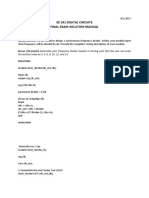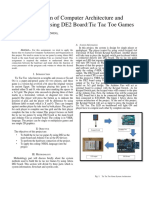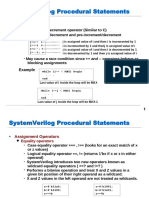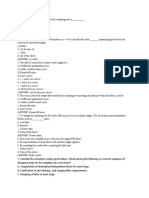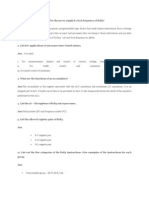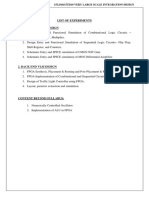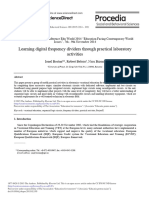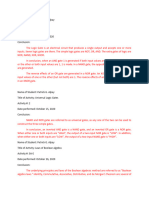100%(2)100% found this document useful (2 votes)
265 viewsAssignment Week4
The document provides solutions to 9 multiple choice questions about Verilog concepts. Question 1 asks about valid targets for procedural assignment statements and the answer is that a "wire" type variable cannot be assigned. Question 2 provides code to calculate the final value of variable "c", which is 75. Question 3 is similar but uses non-blocking assignments, with the final value of "c" being 65.
Uploaded by
saigdv1978Copyright
© © All Rights Reserved
We take content rights seriously. If you suspect this is your content, claim it here.
Available Formats
Download as PDF, TXT or read online on Scribd
100%(2)100% found this document useful (2 votes)
265 viewsAssignment Week4
The document provides solutions to 9 multiple choice questions about Verilog concepts. Question 1 asks about valid targets for procedural assignment statements and the answer is that a "wire" type variable cannot be assigned. Question 2 provides code to calculate the final value of variable "c", which is 75. Question 3 is similar but uses non-blocking assignments, with the final value of "c" being 65.
Uploaded by
saigdv1978Copyright
© © All Rights Reserved
We take content rights seriously. If you suspect this is your content, claim it here.
Available Formats
Download as PDF, TXT or read online on Scribd
You are on page 1/ 3
Week 4: Assignment Solutions
1. Which of the following cannot be used as the target of a procedural
assignment statement?
a. A part select of a “reg” type variable.
b. An “integer” type variable.
c. An output signal of a module that is also declared as “reg”.
d. A “wire” type variable.
Correct answer is (d).
In a procedural assignment statement, only register type variables or part
select thereof can be used in the left hand side. A wire type variable
cannot be assigned a value within a procedural block.
2. For the following code segment, the final value of variable “c” will be
…………..
integer a, b, c;
initial
begin
a = 55; b = 10; c = 5;
a = b * c;
b = a – 25;
c = a + b;
end
Correct answer is 75.
In blocking assignments, statements are executed one after the other.
First assignment: a = 10 * 5 = 50
Second assignment: b = 50 – 25 = 25
Third assignment: c = 50 + 25 = 75
3. For the following code segment, the final value of variable “c” will be
…………..
integer a, b, c;
initial
begin
a = 55; b = 10; c = 5;
end
initial
begin
a <= #10 b * c;
b <= #10 a – 25;
c <= #10 a + b;
end
Correct answer is 65.
In non-blocking statements inside a procedural block, all right hand side
expressions are evaluated in parallel, and are assigned to the left hand side
variables all together.
First assignment: a = 10 * 5 = 50
Second assignment: b = 55 – 25 = 30
Third assignment: c = 55 + 10 = 65
4. What will the following code segment do?
always @(posedge clock)
begin
red = blue;
blue = red;
end
a. Exchange the values of the variables “red” and “blue”.
b. Both variables will get the value previously stored in “red”.
c. Both variables will get the value previously stored in “blue”.
d. None of the above.
Correct answer is (c).
Because the assignments are blocking, first, the value of “blue” will be
assigned to “red”, and then the new value of “red” will be assigned to
“blue”. Thus both the variables “red” and “blue” will get the previous value
stored in “blue”.
5. If the 8-bit variable “data” declared as “reg [7:0] data” is initialized to
8’b10100110, what will be its value after execution of the following code
segment?
always @(posedge clock)
begin
data = data << 1;
data[0] = data[7];
end
a. 8’b01001100
b. 8’b01001101
c. 8’b11001101
d. 8’b11001100
Correct answer is (a).
First data is left shifted by 1 position; its value will become 8’b01001100.
Then data[7], which is 0, is assigned to data[0], which is also 0. So there
will be no change, and the value will remain 8’b01001100.
6. What will the following code segment generate on synthesis, assuming
that the four variables y0, y1, y2 and y3 map into four latches / flip-flops?
always @(posedge clock)
begin
y3 = in;
y2 = y3;
y1 = y2;
y0 = y1;
end
a. A 4-bit shift register.
b. A 4-bit parallel-in parallel-out register.
c. Four D flip-flops all fed with the data “in”.
d. None of the above.
Correct answer is (c).
Since blocking assignment statements are executed one after another,
the value of “in” will be first assigned to “y3”, then to “y2”, then to “y1”,
and finally to “y0”. So the same input will feed all the four D flip-flops
in the synthesized circuit.
7. What will the following code segment generate on synthesis?
always @(posedge clock)
begin
y3 <= in;
y2 <= y3;
y1 <= y2;
y0 <= y1;
end
a. A 4-bit shift register.
b. A 4-bit parallel-in parallel-out register.
c. Four D flip-flops all fed with the data “in”.
d. None of the above.
Correct answer is (a).
Since we use non-blocking assignments, the values on the RHS are
assigned to the variables on the LHS in synchronism with the clock. This
will generate a 4-bit shift register.
8. Which of the following are true for “generate” blocks?
a. Multiple copies of code blocks are generated dynamically before
simulation or synthesis.
b. Can be used to instantiate multiple copies of some module.
c. Must be used along with a variable of type “genvar”.
d. None of the above.
Correct answersare (a), (b) and (c).
All of (a), (b) and (c) are true for “generate” blocks.
9. Which of the following are false for user defined primitives in Verilog?
a. Can be used to specify a combinational circuit with any number of
outputs.
b. Can be used to specify a finite state machine with one or two state
variables.
c. Don’t care or unspecified values are not allowed in the description.
d. None of the above.
Correct answer is (a), (b) and (c).
We can specify a combinational circuit with only one output.
We can specify a FSM with only one state variable.
We can use don’t care (denoted by “?”) to make the description more
compact.
You might also like
- 6th Central Pay Commission Salary Calculator100% (436)6th Central Pay Commission Salary Calculator15 pages
- Computer Organization Hamacher Instructor Manual Solution - Chapter 767% (3)Computer Organization Hamacher Instructor Manual Solution - Chapter 713 pages
- (Ercegovac Milos D., Lang Tomas) Digital Arithmeti (B-Ok - Xyz)0% (1)(Ercegovac Milos D., Lang Tomas) Digital Arithmeti (B-Ok - Xyz)731 pages
- D. Text Based: The Time Period For The Clock #10 Clock ClockNo ratings yetD. Text Based: The Time Period For The Clock #10 Clock Clock5 pages
- Hardware Modeling Using Verilog Assignment-Week 40% (1)Hardware Modeling Using Verilog Assignment-Week 47 pages
- Hardware Modeling Using Verilog - Unit 2 - Week 1 AssignmentNo ratings yetHardware Modeling Using Verilog - Unit 2 - Week 1 Assignment3 pages
- Ee 241 Digital Circuits Final Exam Solution ManualNo ratings yetEe 241 Digital Circuits Final Exam Solution Manual10 pages
- Hardware Modeling Using Verilog Assignment-Week 2No ratings yetHardware Modeling Using Verilog Assignment-Week 25 pages
- Assignment 8 System Design Through VERILOG - Unit 9 - Week 8 - Case StudiesNo ratings yetAssignment 8 System Design Through VERILOG - Unit 9 - Week 8 - Case Studies3 pages
- Chapter 7 - Verilog Tasks and FunctionsNo ratings yetChapter 7 - Verilog Tasks and Functions25 pages
- Hardware Modeling Using Verilog Assignment-Week 2No ratings yetHardware Modeling Using Verilog Assignment-Week 25 pages
- Assignment 7 System Design Through VERILOG - Unit 8 - Week 7 - Test BenchesNo ratings yetAssignment 7 System Design Through VERILOG - Unit 8 - Week 7 - Test Benches4 pages
- Application of Computer Architecture and Organisation Using DE2 BoardNo ratings yetApplication of Computer Architecture and Organisation Using DE2 Board4 pages
- Systemverilog Procedural Statements: New OperatorsNo ratings yetSystemverilog Procedural Statements: New Operators15 pages
- Verilog Labs: Introduction To Lab ExercisesNo ratings yetVerilog Labs: Introduction To Lab Exercises9 pages
- Normal Adder UVM Verification Full Document100% (1)Normal Adder UVM Verification Full Document14 pages
- Radix-4 Modified Booth's Multiplier Using Verilog RTLNo ratings yetRadix-4 Modified Booth's Multiplier Using Verilog RTL10 pages
- Solved ISRO Scientist or Engineer Electronics 2009 Paper With SolutionsNo ratings yetSolved ISRO Scientist or Engineer Electronics 2009 Paper With Solutions22 pages
- System Verilog Interview Questions - 2 ?No ratings yetSystem Verilog Interview Questions - 2 ?24 pages
- VLSI QnA - Interview Questions On Blocking and Nonblocking AssignmentsNo ratings yetVLSI QnA - Interview Questions On Blocking and Nonblocking Assignments3 pages
- Hardware Implementation of Real Time Ecg Analysis AlgorithmsNo ratings yetHardware Implementation of Real Time Ecg Analysis Algorithms127 pages
- Embedded Software in C For ARM Cortex MNo ratings yetEmbedded Software in C For ARM Cortex M114 pages
- Digital System Design & Digital Ic ApplicationsNo ratings yetDigital System Design & Digital Ic Applications4 pages
- Either Source or Destination Is One Of: CPU RegisterNo ratings yetEither Source or Destination Is One Of: CPU Register81 pages
- Arduino Based Home Automation System Using Bluetooth Through An Android Mobile PDF59% (17)Arduino Based Home Automation System Using Bluetooth Through An Android Mobile PDF72 pages
- CMOS Digital Integrated Circuits Analysis Design 2nd Edition Sung-Mo Kang - Download the full set of chapters carefully compiled100% (1)CMOS Digital Integrated Circuits Analysis Design 2nd Edition Sung-Mo Kang - Download the full set of chapters carefully compiled54 pages
- Astable and Monostable Multivibrator Trainer NV6507No ratings yetAstable and Monostable Multivibrator Trainer NV650710 pages
- Quantum Cellular Automata Based Efficient BCD Adder StructureNo ratings yetQuantum Cellular Automata Based Efficient BCD Adder Structure4 pages
- UNIT11 - Latches and Flip-Flops (Part II) PDFNo ratings yetUNIT11 - Latches and Flip-Flops (Part II) PDF17 pages
- DSD Unit-3 Important Questions Solution Year WiseNo ratings yetDSD Unit-3 Important Questions Solution Year Wise24 pages
- Unit Iii: CPLD & Fpga Architecture & Applications100% (7)Unit Iii: CPLD & Fpga Architecture & Applications30 pages
- Spartan-3E FPGA Family: Complete Data Sheet: Introduction and Ordering Information DC and Switching CharacteristicsNo ratings yetSpartan-3E FPGA Family: Complete Data Sheet: Introduction and Ordering Information DC and Switching Characteristics193 pages













